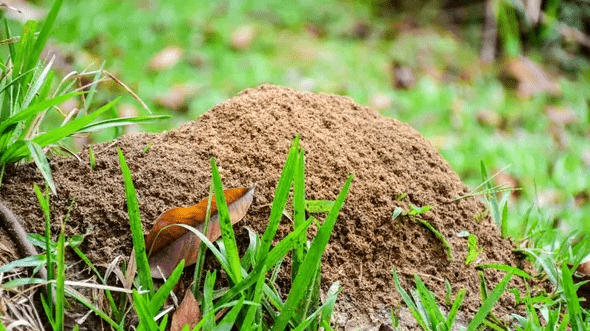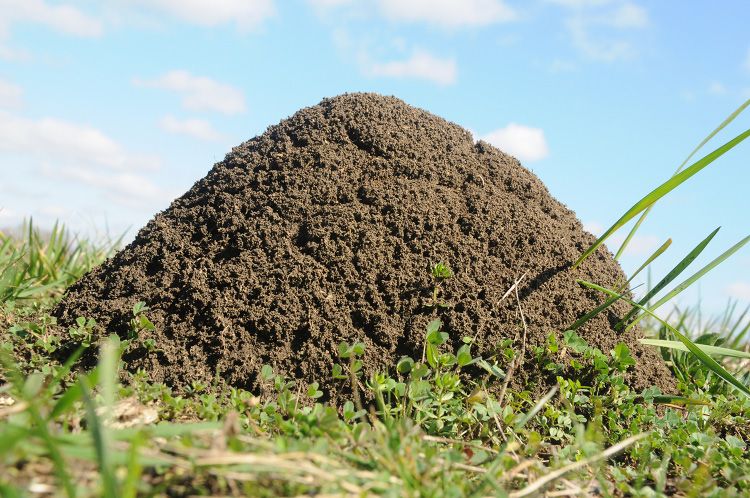Ant hills come in different sizes, ranging from massive, intricate mounds to small dust piles. Aesthetically, ant hills can be a real eyesore if they appear in your garden or lawn, making your otherwise beautiful outdoor space unappealing.
Moreover, ant hills can cause damage to plants and structures in some cases. Therefore, it is best to get rid of ant hills as soon as they appear. Fortunately, you have multiple effective methods at your disposal to get rid of ant hills easily and keep your outdoor space ant-free.
In this guide, we’ll explore a variety of natural and chemical solutions.
Should You Destroy Ant Hills?
Considering that ant hills are mostly harmless, is getting rid of them necessary? Truthfully, destroying any hills has negative and positive outcomes, but this depends on your perspective and the situation. So, before eliminating them, consider both sides.
The upsides of destroying ant hills include:
Preventing Property Damage: Some ants, like carpenter ants, can excavate wood to create their nests, causing structural damage. This can weaken wooden structures and lead to costly repairs. So, getting rid of their home is an important step in getting rid of these destructive insects.
Prevent Infestations: If you let some ant species thrive in your lawn or garden, they can quickly establish massive colonies that might eventually become a nuisance. Destroying smaller ant hills early on could prevent these colonies from growing out of control.
Landscaping: Ant hills don’t look, especially if they appear in places you least want them, like your lawn or garden. Imagine curating a uniform, manicured lawn only for an ant hill to appear out of nowhere.
This will negatively affect your lawn’s appearance, making it less appealing. In addition, their tunnels can cause the ground to become uneven. Removing them might contribute to a more aesthetically pleasing outdoor space.
On the flip side, consider letting Ant Hills be for the following reasons:
Ecological Impact: Ants play important roles in ecosystems, such as aerating soil, decomposing organic matter, and controlling other insect populations. Their tunneling activities enhance soil structure, which can be vital for plant growth. By destroying ant hills, you risk disrupting these ecological functions.
Species Diversity: Ants are incredibly diverse, with thousands of species worldwide. These insects contribute to overall biodiversity and are often key components of food webs, providing food for other organisms like birds, reptiles, and mammals. If you eliminate ant hills, you could disrupt this balance and impact other species that depend on ants for food or other interactions.
Not every ant hill has to be destroyed. Therefore, when deciding whether to get rid of ant hills, consider the specific ant species, their behavior, and the potential impacts on your property and environment.
Related Posts:
How To Get Rid Of Ant Hills Easily
As I mentioned earlier, you can destroy ant hills through various methods. You just have to choose your most suitable approach.
Natural Methods of Destroying Ant Hills
Consider these methods if you wish to avoid using chemicals to get rid of ant hills.
1. Pour Boiling Water
This method is simple, time-tested, and environmentally friendly. It’s particularly effective againstsmall to medium-sized ant hills. Time the application time to be during warm weather when ants are most active near the surface.
The effectiveness of this method lies in the boiling water’s extreme heat as it not only kills many ants on contact but also disrupts the intricate structure of the ant colony.
- Boil water in a kettle or pot.
- Identify the location of the ant hill you want to target. Be cautious and avoid disturbing the ants before you’re ready to pour the boiling water.
- Put on protective clothing such as closed-toe shoes and gloves to prevent any accidental bites.
- Slowly and carefully pour the boiling water into the entrance of the ant hill. Aim for the center of the mound to ensure the water reaches as deep as possible into the colony.
- After pouring the boiling water, keep an eye on the ant hill for activity. You may see a significant decline in ant movement shortly after treatment. You may need to repeat the process for larger colonies to ensure complete eradication.
2. Sprinkle Diatomaceous Earth
Sprinkle a generous amount of diatomaceous earth around the ant hill’s entrance and directly onto the mound, ensuring you cover the areas where ants are active. The powder will destroy the ants’ exoskeletons, dehydrating and eventually killing them.
Apply Diatomaceous Earth during dry days when rain isn’t expected in the immediate future since this substance is most effective in dry conditions. Wet conditions diminish its abrasive properties.
Safely remove the ant hill using a shovel and disperse the soil in your garden or outdoor area after the ant activity has stopped and the colony appears to be eliminated.
3. Try Vinegar Solution
Vinegar’s strong odor disrupts ants’ pheromone trails and deters them from returning to the area.This makes this natural substance an effective weapon against ant hills and ants. Thoroughly spray the vinegar solution (equal parts water and vinegar) onto the ant hill and the surrounding area, focusing on the entrance and any visible ant trails.
Keep in mind that vinegar can harm surrounding plants, so apply carefully.
4. Citrus Peels
Citrus peels could be your answer if you’re seeking a natural and aromatic solution to get rid of ant hills. Ants find the natural oils in citrus peels repulsive, so placing citrus peels near ant hills and entry points creates an environment ants want to avoid.
This method not only helps deter ants from invading your space but also adds a pleasant fragrance to your surroundings. Citrus peels lose their potency over time as the essential oils evaporate. Therefore, replace the peels regularly, approximately every week, to maintain their effectiveness.
5. Fizz Away Ant Hills Using Carbonated Water
For an unconventional yet effective method against ant hills, consider using carbonated water. The dissolved CO2 gas in carbonated water creates fizz and bubbles.
If you pour carbonated water into an ant hill, the release of carbon dioxide disrupts the ants’ environment by displacing air and moisture. This can ultimately suffocate the ants and force them to abandon the hill.
6. Mix Boric Acid and Sugar
Create an enticing bait for ants that will kill the ants inside the ant hill by combining boric acid with sugar. Sugar attracts ants, causing them to carry the boric acid and sugar remedy back to the colony. Once consumed, the boric acid will disrupt their digestive systems and lead to the demise of the entire colony, including the queen.
Thoroughly mix the boric acid and sugar to create a consistent bait. The sugar helps disguise the bitter taste of boric acid. Position the bait stations close to ant trails and the entrance of the ant hill.
7. Flatten The Ant Hill
While natural remedies like Diatomaceous Earth and vinegar work against an ant hill, why not use a more straightforward approach by flattening it? This simple method involves physically disrupting the structure of the mound. This action can cause discomfort to the ants and temporarily disturb their activities.
While flattening ant hills won’t eliminate the colony completely, it reduces the visual impact of the mounds and deter ants from staying in the area.
Using the shovel, board, or rake, gently press down on the ant hill to flatten it. Begin from the edges,then gradually proceed toward the center to avoid crushing ants. Taking the ants’ persistency into account, flatten the ant hill regularly for the method to be effective.
Chemical Methods of Destroying Ant Hills
While chemicals are not friendly to the environment, humans, and even pets, you cannot deny their effectiveness against ant hills. So, consider these methods.
8. Use Ant Baits
Ant baits, like Amdro Granules Fire Ant Bait for fire ants, are a highly effective method that eliminates the ants you see and reaches the hidden colony, including the queen. If ants come across baits, they carry them back to the colony, sharing them with other ants, including the queen. Over time, the insecticide disrupts the colony, ultimately leading to its elimination.
Ant baits come in various formulations, including liquid and gel baits. In that case, you must purchase ant bait products specifically designed for the ant species you’re dealing with.
9. Insecticidal Sprays
This is a good choice if you want a quick and direct solution to get rid of ant hills. Insecticidal sprays often contain active ingredients that disrupt the insects’ nervous systems, causing paralysis and eventual death. Use it appropriately, and the insecticidal sprays will provide rapid relief from ant infestations, including the visible ant hills.
Minimize the impact on non-target insects and increase the spray’s effectiveness by applying the insecticidal spray directly onto the ant hill rather than over-spraying the surrounding area.
Summary
Effectively eliminating ant hills from your yard or garden doesn’t have to be a time-consuming or complicated process. However, you’ll need to understand the nature of the ant hills on your property and decide whether you prefer environmentally friendly methods or are open to using chemical solutions.
Remember that you must kill the queen of the colony in order to get rid of the ant hill permanently.

Hey there, I’m Derek Schew, a writer for Lawnholic.com, where we cover everything and anything related to lawns. As someone who’s spent countless hours tending to my own lawn, I’m passionate about sharing my knowledge and helping others achieve the perfect yard. From lawn care tips to product reviews, I’m committed to providing our readers with the most accurate and up-to-date information available. So whether you’re a seasoned lawn enthusiast or just getting started, I invite you to join our community and discover the joys of a lush, green lawn.


